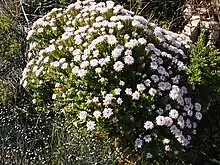| Pimelea ferruginea | |
|---|---|
 | |
| At Cape Naturaliste | |
| Scientific classification | |
| Kingdom: | Plantae |
| Clade: | Tracheophytes |
| Clade: | Angiosperms |
| Clade: | Eudicots |
| Clade: | Rosids |
| Order: | Malvales |
| Family: | Thymelaeaceae |
| Genus: | Pimelea |
| Species: | P. ferruginea |
| Binomial name | |
| Pimelea ferruginea | |
| Synonyms[1] | |
| |

Pimelea ferruginea, commonly known as pink rice flower[2] or coastal banjine,[3] is a species of flowering plant in the family Thymelaeaceae and is endemic to near-coastal areas of south-western Western Australia. It is a dense, erect shrub with elliptic to narrowly elliptic leaves and head-like clusters of pale to deep pink, tube-shaped flowers.
Description
Pimelea ferruginea is a dense, erect shrub that typically grows to a height of 0.3–1.5 m (1 ft 0 in – 4 ft 11 in) and usually has a single stem at ground level. The leaves are elliptic to narrowly elliptic with the edges curved down, 5–16 mm (0.20–0.63 in) long and 1.5–6.5 mm (0.059–0.256 in) wide on a petiole 0.1–1 mm (0.0039–0.0394 in) long. The flowers are pale to deep pink and borne in erect, head-like clusters on a hairy peduncle 0.5–1.2 mm (0.020–0.047 in) long, surrounded by 4 broadly egg-shaped bracts 5–14 mm (0.20–0.55 in) long, each flower on a hairy pedicel 0.5–1.2 mm (0.020–0.047 in) long. The floral tube is 7–13 mm (0.28–0.51 in) long, the sepals 2.5–4 mm (0.098–0.157 in) long. Flowering mainly occurs from August to February.[3][4][5]
Taxonomy
Pimelea ferruginea was first formally described in 1805 by Jacques Labillardière in his Novae Hollandiae Plantarum Specimen.[6][7] The specific epithet (ferruginea) means "rust-coloured".[8]
Distribution and habitat
Pink rice flower grows on coastal sand dunes and rocky headlands in near-coastal areas between Cliff Head near Arrowsmith, and Point Culver, in the Esperance Plains, Geraldton Sandplains, Jarrah Forest, Mallee, Swan Coastal Plain and Warren bioregions of south-western Western Australia.[9]
Conservation status
Pimelea ferruginea is listed as "not threatened" by the Government of Western Australia Department of Biodiversity, Conservation and Attractions.[9]
References
- 1 2 "Pimelea ferruginea". Australian Plant Census. Retrieved 14 November 2022.
- ↑ "Pimelea ferruginea". Australian Native Plants Society (Australia). Retrieved 14 November 2022.
- 1 2 Rye, Barbara L. (1999). "An updated revision of Pimelea sect. Heterolaena (Thymelaeaceae), including two new taxa". Nuytsia. 13 (1): 174–177. Retrieved 14 November 2022.
- ↑ Rye, Barbara L. "Pimelea ferruginea". Flora of Australia. Australian Biological Resources Study, Department of Agriculture, Water and the Environment: Canberra. Retrieved 14 November 2022.
- ↑ Rye, Barbara L. (1988). "A revision of Western Australian Thymelaeaceae". Nuytsia. 6 (2): 251. Retrieved 14 November 2022.
- ↑ "Pimelea ferruginea". APNI. Retrieved 14 November 2022.
- ↑ Labillardière, Jacques (1805). Novae Hollandiae plantarum specimen. Paris. pp. 10–11. Retrieved 14 November 2022.
- ↑ Sharr, Francis Aubi; George, Alex (2019). Western Australian Plant Names and Their Meanings (3rd ed.). Kardinya, WA: Four Gables Press. p. 198. ISBN 9780958034180.
- 1 2 "Pimelea ferruginea". FloraBase. Western Australian Government Department of Biodiversity, Conservation and Attractions.